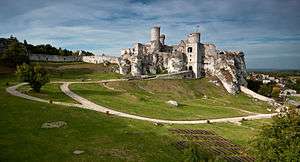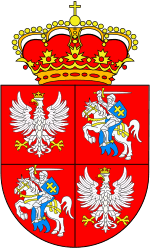Ogrodzieniec Castle
Ogrodzieniec Castle (English: Ogro-denetz) is a ruined medieval castle in the semi-mountainous highland region called the Polish Jura in south-central Poland. Rebuilt several times in its history, the castle was originally built in the 14th–15th century by a wealthy noble family.[1] The castle is situated on the 515.5-metre-high Castle Mountain (Polish: Góra Zamkowa), the highest hill of the Kraków-Częstochowa Upland. Located on the Trail of the Eagles' Nests, the ruins are open to visitors.



History
Established in the early 12th century, during the reign of Boleslaus III Wrymouth, the first stronghold was razed by the Tatars in 1241. In the mid-14th century a new gothic castle was built here to accommodate the Włodek Sulima family. Surrounded by three high rocks, the castle was well integrated into the area. The defensive walls were built to close the circuit formed by the rocks, and a narrow opening between two of the rocks served as an entrance.[2]
In 1470, the castle and lands were bought by the wealthy Cracovian townsmen, Ibram and Piotr Salomon. Then, Ogrodzieniec became the property of Jan Feliks Rzeszowski, the rector of Przemyśl and the canon of Kraków. Around 1488, the castle was owned by Jan and subsequently Andrzej Rzeszowski and, later, the Pilecki and Chełmiński families. In 1523 the castle was bought by Jan Boner. After his death, the castle passed to his nephew, Seweryn Boner, who replaced the medieval stronghold with a renaissance castle in 1530–1545.[3][4]
In 1562, the castle became the property of the Great Marshal of the Crown Jan Firlej, as a result of his marriage to Zofia, the daughter of Seweryn Boner. In 1587, the castle was captured by the Austrian archduke Maximilian III, the rejected candidate to the Polish-Lithuanian throne. In 1655, it was partly burnt by the Swedish troops, who – deployed there for almost two years – damaged the buildings considerably. From 1669 on, the castle belonged to Stanisław Warszycki, the Kraków's castellan, who managed to partly rebuild the castle after the Swedish devastations.[2]
About 1695, the castle changed hands once again, becoming the property of the Męciński family. Seven years later, in 1702, over half of the castle burned in a fire set by troops of Charles XII of Sweden. After that fire, it was never rebuilt. About 1784, the ruined castle was purchased by Tomasz Jakliński.[5] The last tenants left the devastated castle about 1810. The next owner was Ludwik Kozłowski, who used the remains of the castle as a source of building material and sold many items from castle to merchants.[6][7]
The last proprietor of the castle was the neighbouring Wołoczyński family. After the Second World War, the castle was nationalized. The work to preserve the ruins and open them to visitors was started in 1949 and finished in 1973.[8]
Interesting facts

On the bottom floor, fragments of the renaissance frescos of lilies are still visible.
Close to the castle, on the market of Podzamcze village, stands a chapel built from architectural elements (portal, volutes, cornice) of the castle. Inside the chapel are original elements of the castle chapel: the vault keystone, round shot said to have fallen into the castle during the Swedish Deluge (1655–1660), and a Renaissance Our Lady sculpture. The sculpture has been painted in the folk style (with oil paint) by the locals, obscuring its original appearance.
According to local folklore[9], the Ogrodzieniec Castle is haunted by the "Black Dog of Ogrodzieniec", seen prowling the ruins at night, pulling a heavy chain. The dog is to be the soul of the Castellan of Kraków, Stanisław Warszycki, whose soul also supposedly haunts the ruins of the Dańków Castle, where it appears as a headless horseman.[10]
In film and television
In 1973, Ogrodzieniec Castle was used for outdoor scenes in the television series Janosik.[11]
In 1980, the film The Knight by Lech Majewski was shot in the castle.[12]
In 1984, the castle was used in the band Iron Maiden's Behind The Iron Curtain, in the video for the song "Hallowed Be Thy Name".[13][14]
In 1995, the castle was used to depict the ruins of the old Spellbinder's castle in the Australian television series Spellbinder.[15]
In 2001, the ruins were used as scenery for Andrzej Wajda's film The Revenge. For the purpose of filmmaking, large decorations were built in the castle; these remained there after filming was finished.[16]
In 2018, the ruins of the castle were used during filming of The Witcher - Netflix's 2019 series, starring Henry Cavill.[17][18]
Gallery
 The Ogrodzieniec Castle- view from the East
The Ogrodzieniec Castle- view from the East Panorama of the castle
Panorama of the castle- The torture chamber as seen from the tower
- The torture chamber
- A tower of the Ogrodzieniec Castle with the Polish flag
- The castle windows
- The castle walls
 The castle walls
The castle walls- The castle walls
.jpg) The South wall of the Ogrodzieniec Castle (2012-08-26)
The South wall of the Ogrodzieniec Castle (2012-08-26) Inside castle
Inside castle
See also
- Ogrodzieniec
- Trail of the Eagle's Nests
- Castles in Poland
References
- "Podzamcze – Ogrodzieniec Castle", Castles in Poland
- "Historia". Retrieved 25 November 2019.
- "Historia". Retrieved 25 November 2019.
- "Zamek Ogrodzieniec. Historia. Atrakcje". Retrieved 25 November 2019.
- "Ogrodzieniec i Gród na Górze Birów - pomiędzy Krakowem a Częstochową". Przekraczając Granice. 14 May 2016.
- "Zamek w Ogrodzieńcu". Retrieved 25 November 2019.
- "Ogrodzieniec Castle. Historia". Retrieved 26 November 2019.
- "Ruiny zamku Ogrodzieniec. Historia". Retrieved 26 November 2019.
- "Old Haunts: Exploring Poland's Spookiest Spots". Retrieved 31 December 2019.
- Bogna Wiernikowska, Maciej Kozłowski "Duchy polskie" 1985
- "JANOSIK - GDZIE POWSTAWAŁ KULTOWY POLSKI SERIAL". Retrieved 26 November 2019.
- "ZAMEK OGRODZIENIEC". Retrieved 26 November 2019.
- "Ogrodzieniec Castle". Retrieved 26 November 2019.
- "The Trail of the Eagle Nests, named after a chain of 25 mostly derelict medieval castles". Retrieved 26 November 2019.
- "Zamki w Polsce - najpiękniejsze, najciekawsze i najsłynniejsze obiekty na zdjęciach i mapie". Retrieved 26 November 2019.
- "Podzamcze". Retrieved 26 November 2019.
- "Redanian Archives XI: Behind the Scenes of The Witcher's Filming in Poland". Retrieved 26 November 2019.
- "'The Witcher' Netflix Series Now Filming in Poland". Retrieved 26 November 2019.
